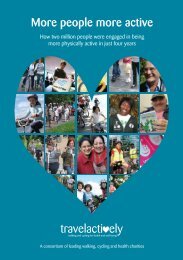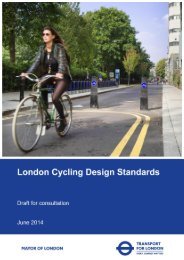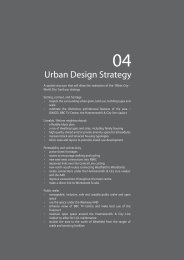Travel in London Travel in London
travel-in-london-report-8
travel-in-london-report-8
Create successful ePaper yourself
Turn your PDF publications into a flip-book with our unique Google optimized e-Paper software.
2. Overall travel trends <strong>in</strong> <strong>London</strong><br />
• In terms of mode share for public transport, there was a 3.0 per cent net<br />
shift at the trip level, and a 2.9 per cent net shift at the journey stage level,<br />
between 2008 and 2014. This is much greater than the MTS expectation of<br />
a net change <strong>in</strong> mode share of 0.2 per cent over the same period, and<br />
cont<strong>in</strong>ues the consistent trend that has been seen <strong>in</strong> <strong>London</strong> over the last<br />
14 years, with a 10.1 per cent shift <strong>in</strong> net mode share towards public<br />
transport, walk<strong>in</strong>g and cycl<strong>in</strong>g s<strong>in</strong>ce 2000.<br />
2.7 Morn<strong>in</strong>g peak travel to central <strong>London</strong><br />
Background – the CAPC and Isle of Dogs Cordon Surveys<br />
S<strong>in</strong>ce the late 1970s TfL have monitored the numbers of people enter<strong>in</strong>g<br />
central <strong>London</strong> dur<strong>in</strong>g the weekday morn<strong>in</strong>g peak period (07:00 to 10:00)<br />
through a long-established yearly count, taken <strong>in</strong> the autumn. The Central Area<br />
Peak Count (CAPC) survey covers all modes except walk<strong>in</strong>g and those travell<strong>in</strong>g<br />
<strong>in</strong> commercial vehicles or travell<strong>in</strong>g as part of their job (for example, licensed<br />
taxi drivers). Most of these people are commut<strong>in</strong>g to work <strong>in</strong> central <strong>London</strong>,<br />
and this <strong>in</strong>dicator provides a good picture of this one specific, but important,<br />
aspect of travel <strong>in</strong> <strong>London</strong>.<br />
With the regeneration of <strong>London</strong> Docklands dur<strong>in</strong>g the late 1980s, TfL<br />
extended this idea and <strong>in</strong>stituted a similar cordon-based count survey to cover<br />
the Isle of Dogs. As well as the AM peak period this survey covers an extended<br />
weekday (05:00 to 23:00). Over the past 25 years, <strong>London</strong> Docklands has<br />
developed as an area of high density high-value employment, primarily <strong>in</strong><br />
f<strong>in</strong>ancial and bus<strong>in</strong>ess services, to complement the historic centre of these<br />
activities <strong>in</strong> central <strong>London</strong>. Taken together, therefore, the travel trends<br />
revealed by both surveys provide valuable <strong>in</strong>sight <strong>in</strong>to the growth and dynamics<br />
of travel to these two key central <strong>London</strong> employment hubs.<br />
Morn<strong>in</strong>g peak travel to central <strong>London</strong> (CAPC)<br />
Long-term trends<br />
Figure 2.5 shows the trend for the total number of people enter<strong>in</strong>g central<br />
<strong>London</strong> over the past 36 years. The year 2014 saw the highest number of<br />
people enter<strong>in</strong>g central <strong>London</strong> <strong>in</strong> the morn<strong>in</strong>g peak s<strong>in</strong>ce the current survey<br />
started <strong>in</strong> 1978 – 1.26 million. The total number of people enter<strong>in</strong>g has varied<br />
relatively little over the period of the survey. These variations tend to follow<br />
the economic cycle <strong>in</strong> central <strong>London</strong> and <strong>in</strong>terest<strong>in</strong>gly show no clear trend<br />
over much of the period, although the trend over recent years has been sharply<br />
upwards.<br />
37 <strong>Travel</strong> <strong>in</strong> <strong>London</strong>, Report 8








